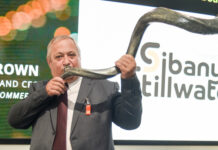
COPPER 360 has shown what’s possible in South Africa’s junior mining sector. Since the miner cropped up in 2020 as Cape Copper Oxide Co, Jan Nelson has established an operational footprint in double-quick time, largely because the strategy is to redevelop previously mined resources.
His rival, Orion Minerals CEO Errol Smart, considers that a host of other “new” developments can be unlocked in exactly this way. “Investors don’t want greenfields projects [as much as] brownfields ones. That is the low-hanging fruit,” said Smart at the recent Junior Indaba.
Orion Minerals is an Australian-listed firm which, like Copper 360, is redeveloping previously worked resources in the Northern Cape. Orion’s pathway hasn’t been quite as smooth as Copper 360’s, which can be partly explained by two circumstances.
The first is that Orion has been a pioneer in brownfields development in the Northern Cape: drilling of its Prieska copper-zinc project first took place as early as in 2016, and a Joburg listing followed a year later. Hazards that accompany first-mover “advantage” include having to tackle the department of minerals & energy (DMRE). Never a well-oiled cog under previous presidencies, the DMRE managed under former president Jacob Zuma to perfect dysfunction.
The second reason for Orion’s slower pathway is that the company is hoping to reopen an underground copper mine. More complex than surface mining of the type being carried out by Copper 360, Orion’s Prieska copper-zinc project needs billions of rands in project capital. It has required Smart to re-examine project scope and timing.
Despite this, however, Smart is more bullish of his firm’s prospects — and of those of the junior mining sector in general — than ever before. A service level agreement (SLA) for a new minerals cadastre was signed on May 20, the day before Smart spoke at the conference. In fact, he only learnt of its signing when conference panel member Tseliso Maqubela, a deputy director-general in the DMRE, told him about it.
“I’m coming off an all-time rush on hearing this news,” Smart declared when asked to comment. “I know I keep hammering on about a minerals cadastre, but it’s a way to measure — and when you can measure you can manage. It will test us all,” he said.
With a minerals cadastre now in development, South Africa’s junior mining sector can finally take off, Smart declared.
“We’re not very good at telling our story,” said Maqubela at the conference. But in truth, there hasn’t been a story to tell.
According to Marula Mining MD Jason Brewer, were the country’s 600 or so closed or discontinued mines located in Australia rather than having their documents collecting dust on the DMRE’s shelves, roughly half would have been developed by now.
Smart said: “With this SLA, we can get moving, and stop the talking, talking, talking that we do.”
A version of this article first appeared in the Financial Mail.











